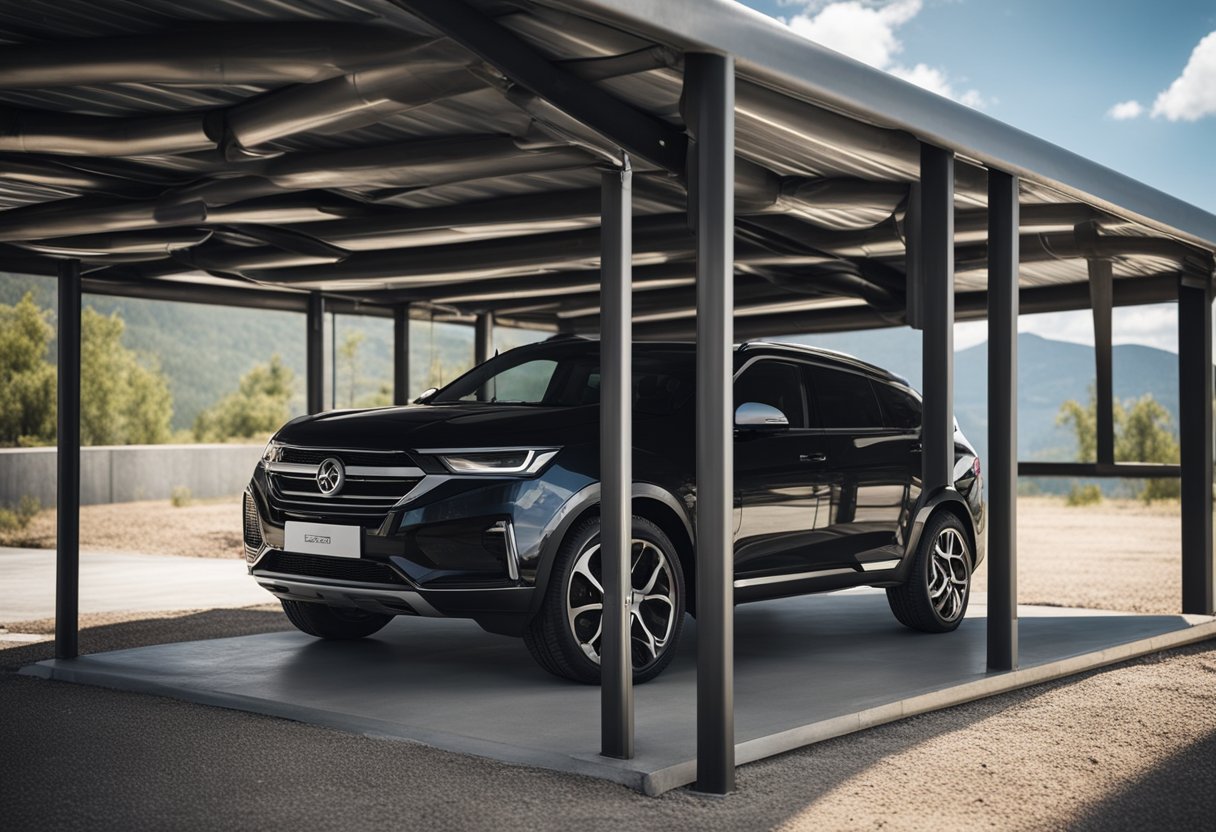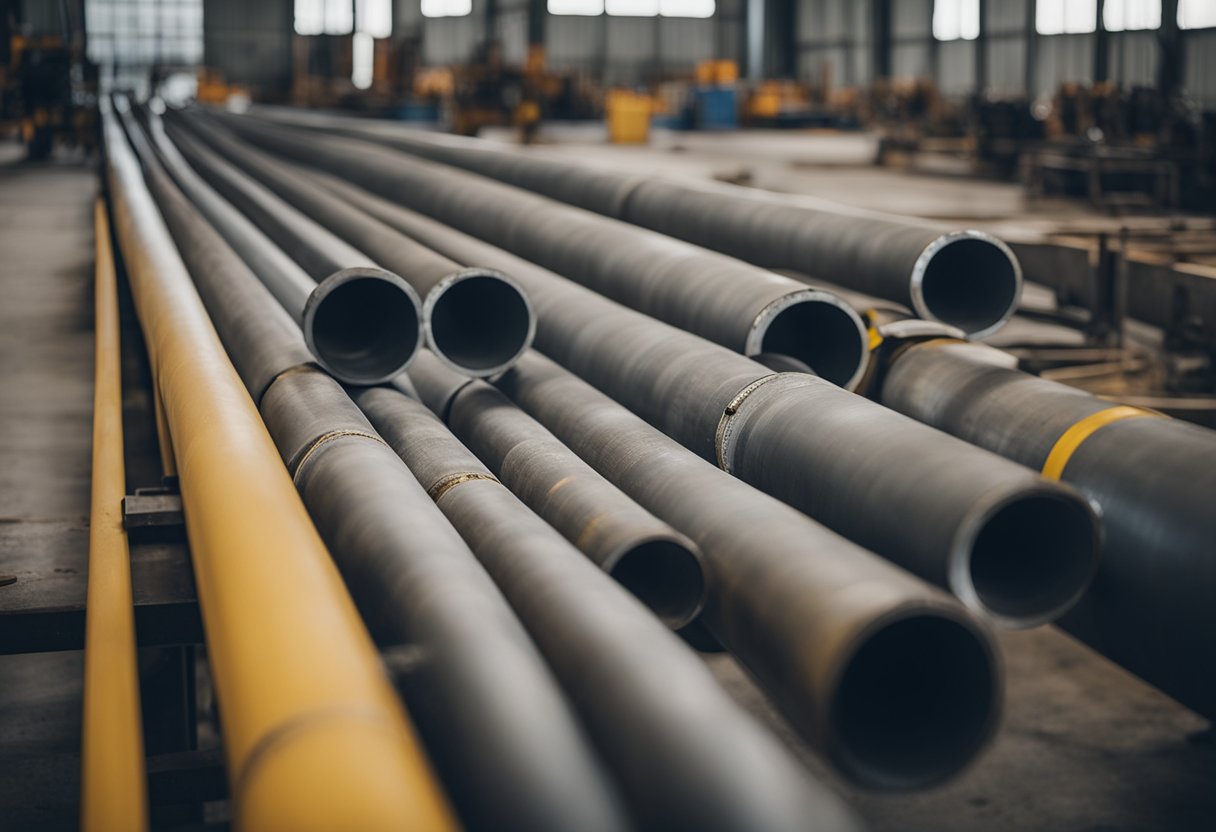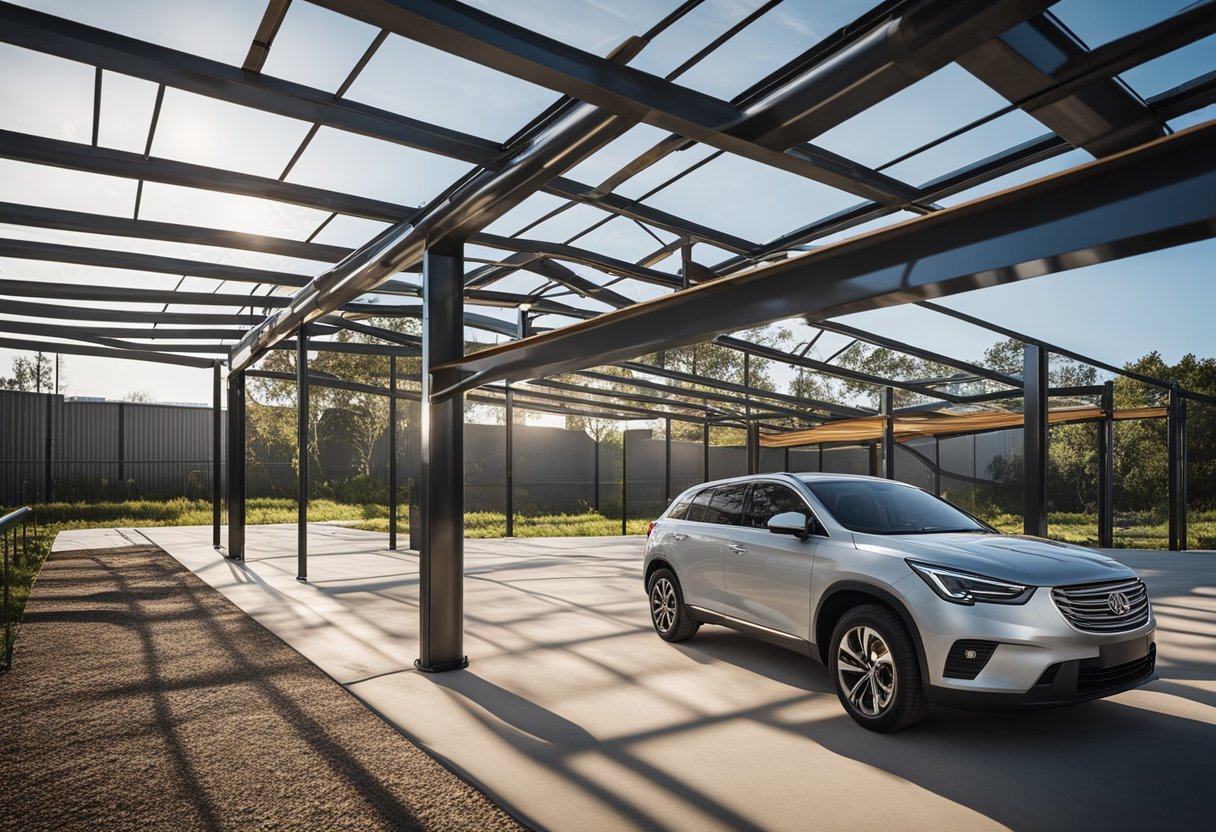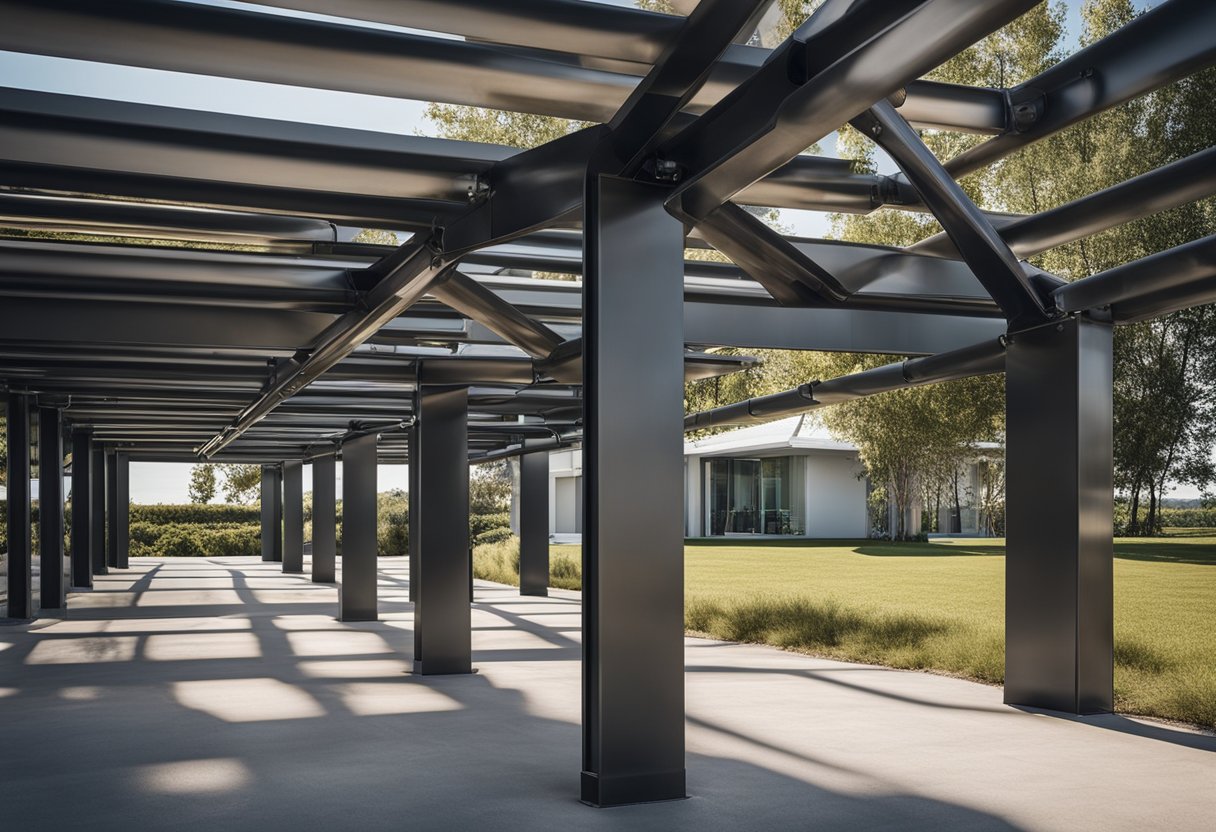Building a carport out of steel pipe is a great DIY project for anyone looking to protect their vehicle from the elements. Not only is it a cost-effective solution compared to traditional carports, but it can also be customized to fit your specific needs. In this article, I will guide you through the steps on how to build a carport out of steel pipe.

To begin, you’ll need to design your steel pipe carport. This includes determining the size, shape, and style of your carport. You’ll also need to decide on the type of roofing material you want to use. Once you have a design in mind, you can start gathering the materials and tools required for the project.
Key Takeaways
- Design your steel pipe carport based on your specific needs.
- Gather all the necessary materials and tools before starting the project.
- Make sure to choose the right location and prepare the ground before constructing the carport.
Designing Your Steel Pipe Carport
When designing your steel pipe carport, there are a few things to consider. First, you need to determine the desired dimensions, including the width, length, and height of the structure. This will depend on the size of the vehicles or items you want to store under the carport. You will also need to consider any local building codes or regulations that may impact the design.
One of the benefits of building a carport out of steel pipe is that it can be freestanding or attached to your home. If you choose to attach it to your home, you will need to make sure that it is properly secured to the building and that it meets any local building codes.
When it comes to height, you will need to consider the height of the vehicles or items you want to store under the carport. Make sure that the carport is tall enough to accommodate your needs.
It is important to have detailed plans before starting the construction process. This will help ensure that you have all the necessary materials and that the carport is built to the correct specifications. You may want to consult with a professional or use a pre-made plan to ensure that your carport is built correctly.
Overall, designing a steel pipe carport for your residential property can be a great way to protect your vehicles and other items from the elements. With careful planning and attention to detail, you can create a sturdy and functional carport that will last for years to come.
Materials and Tools Required

To build a carport out of steel pipe, you will need a variety of materials and tools. Here is a list of what you will need:
Materials
- Steel pipe: This is the main material you will need to construct the carport. You can use galvanized steel pipe or steel tubing, depending on your preference.
- Lumber: You will need lumber to create the frame of the carport. You can use standard 2x4s or 2x6s.
- Plywood: You will need plywood to create the roof of the carport. Corrugated metal sheets or other roofing material can also be used.
- Concrete: You will need concrete to create the footings for the carport. You can use pre-mixed bags or mix your own.
- Gravel: You will need gravel to fill the bottom of the post holes to provide drainage.
- Red oxide primer: You will need red oxide primer to coat the steel pipe to prevent rust.
- L beams: You will need L beams to attach the roof frame to the carport frame.
- Ridge cap and gable trim: You will need these materials to finish the roof of the carport.
Tools
- Pipe cutter: You will need a pipe cutter to cut the steel pipe to the correct length.
- Pipe wrench: You will need a pipe wrench to tighten the pipe fittings.
- Drill: You will need a drill to make holes in the steel pipe and lumber.
- Level: You will need a level to ensure that the carport is level.
- Measuring tape: You will need a measuring tape to measure the length of the steel pipe and lumber.
- Screwdriver: You will need a screwdriver to attach the plywood to the roof frame.
- Saw: You will need a saw to cut the lumber to the correct length.
With these materials and tools, you will be able to construct a sturdy and durable carport out of steel pipe.
Choosing the Right Location
When it comes to building a carport out of steel pipe, choosing the right location is crucial. Here are some factors to consider when selecting the perfect spot for your carport:
Location
Choosing the right location for your carport is important. You want to make sure that it is easily accessible and that it is located in a convenient spot. You should also consider the size of the carport and make sure that it will fit in the location that you have chosen.
Foundation
The foundation is important because it will provide the support that your carport needs. You should make sure that the foundation is level and that it is strong enough to support the weight of the carport and your vehicle. You may need to hire a professional to help you with this step.
Permits
Before you start building your carport, you should check with your local government to see if you need any permits or approvals. In some areas, you may need a permit to build a carport. You should also make sure that you are following all of the local building codes and regulations.
Building Codes
Building codes can vary from area to area, so it is important to make sure that you are following all of the codes and regulations that apply to your location. This will help ensure that your carport is safe and that it will last for many years.
Plans and Permits
Before you start building your carport, you should have a plan in place. This plan should include the size of the carport, the materials that you will be using, and the location where you will be building it. You should also make sure that you have all of the necessary permits and approvals before you start building.
By considering these factors, you can ensure that you choose the right location for your carport and that it will be safe and durable.
Preparing the Ground and Setting Up the Frame
Before starting the construction of a steel pipe carport, it’s important to prepare the ground properly. Here are the steps I followed:
-
Measure the area where the carport will be placed. The average car needs at least 16 x 9 feet of space. However, if you plan to park multiple vehicles or a bigger car or truck, you’ll need a larger space.
-
Identify any plumbing, gas, and power lines in the area to determine a safe location for your carport. Avoid placing the carport under trees if possible.
-
Plot out the space for your carport using string lines. This will help you visualize the area and ensure that the carport is level.
-
Dig the holes for the carport posts. The depth of the holes will depend on the height of the carport. Typically, the holes should be at least 2 feet deep.
-
Set the posts in the holes and secure them with concrete. Use a level to ensure that the posts are plumb.
-
Install the anchors on top of the posts. The anchors will hold the steel pipe frame in place.
-
Drill the steel pipe to create holes that align with the anchors. This will allow you to secure the frame to the anchors.
-
Install the steel pipe frame on top of the posts and secure it with screws. Use a level to ensure that the frame is level.
-
Install the crossbeams and trusses to complete the frame.
By following these steps, you can create a sturdy and durable steel pipe carport that will protect your vehicles from the elements.
Constructing the Carport
Now that I have gathered all the materials and tools needed, it is time to start constructing the carport. The first step is to mark the area where the carport is going to be installed. I will use stakes and string lines to mark the area and ensure that the carport is level.
Next, I will begin constructing the support beams. I will use steel pipes for the support beams as they are sturdy and durable. The support beams will be placed in post-hole supports that have been dug into the ground. I will ensure that the support beams are level and secure before moving on to the next step.
Once the support beams are in place, I will begin constructing the trusses. The trusses will be made by welding together steel pipes and square tubing. The trusses will then be attached to the support beams using bolts and brackets.
After the trusses have been installed, I will begin constructing the rafters. The rafters will be made by welding together steel pipes and square tubing. The rafters will then be attached to the trusses using bolts and brackets.
Finally, I will install the roof by attaching the scaffold to the rafters. The scaffold will be made of plywood and will be secured to the rafters using bolts and brackets. The roof will then be covered with metal sheets to provide protection from the elements.
Overall, constructing a carport out of steel pipe requires some carpentry skills and knowledge of carport installation. However, with the right tools and materials, it can be a straightforward process that can save you money on labor costs.
Finishing and Painting the Carport
After constructing the steel pipe carport, it is time to finish and paint it. The finishing process involves removing any rough edges, sharp points, or burrs that could cause injury. It also includes sanding the surface to make it smooth and free of any rust or debris. I recommend using a wire brush to remove any rust and debris from the steel pipes.
Once the steel pipes are clean and smooth, it is time to apply a finish. A finish is a protective coating that helps to prevent rust and corrosion. There are several types of finishes available, including powder coating, galvanizing, and painting. I prefer painting because it is affordable, easy to apply, and provides a durable finish.
Before painting, it is important to choose the right type of paint. I recommend using a high-quality paint that is designed for metal surfaces. It should also be weather-resistant, durable, and easy to clean. You can choose from a wide range of colors to match your home or landscape.
To paint the carport, start by applying a primer coat. The primer helps the paint adhere to the surface and provides additional protection against rust and corrosion. Apply the primer using a paintbrush or roller and allow it to dry completely before applying the final coat of paint.
Once the primer is dry, it is time to apply the final coat of paint. Use a paintbrush or roller to apply the paint evenly, making sure to cover all surfaces. Allow the paint to dry completely before using the carport.
In conclusion, finishing and painting the steel pipe carport is an important step that helps to protect it from rust and corrosion. By following these simple steps, you can ensure that your carport looks great and lasts for years to come.
Maintaining Your Steel Pipe Carport

Maintaining a steel pipe carport is relatively easy and straightforward. Steel pipe carports are durable and strong, and when properly maintained, they can last for many years. Here are some tips on how to maintain your steel pipe carport:
Regular Cleaning
One of the easiest ways to maintain your steel pipe carport is by regularly cleaning it. Dirt, dust, and debris can accumulate on the carport, which can cause damage over time. Use a mild detergent and a soft-bristled brush to clean the carport. Rinse it off with a hose and let it air dry.
Inspect for Damage
Regularly inspect your steel pipe carport for any signs of damage. Check for rust, dents, or any other damage. If you notice any damage, take immediate action to repair it. Rust can weaken the steel, and dents can compromise the structural integrity of the carport.
Protect from the Elements
Steel pipe carports are designed to provide protection from the elements, but they can still be damaged by extreme weather conditions. During heavy rain or snow, make sure to clear off any snow or debris from the carport. This will prevent any damage caused by the weight of the snow or debris.
Cost-Effective
Steel pipe carports are cost-effective and provide a cost-efficient way to protect your vehicles from the elements. They are cheaper than traditional carports made of wood or metal. They are also lightweight, which makes them easy to install and move.
Durability
Steel pipe carports are durable and strong. They are designed to withstand harsh weather conditions and provide long-lasting protection for your vehicles. With proper maintenance, a steel pipe carport can last for many years.
In conclusion, maintaining your steel pipe carport is relatively easy and straightforward. Regular cleaning, inspection for damage, protection from the elements, and cost-effectiveness are some of the benefits of owning a steel pipe carport. With proper maintenance, your steel pipe carport can provide long-lasting protection for your vehicles.
Benefits and Challenges of Steel Pipe Carports

As a DIY enthusiast, I find building carports using steel pipes to be a great option due to the numerous benefits it offers. Here are some of the benefits of using steel pipes for carports:
-
Greater strength: Steel pipes are stronger than wood or aluminum, making them a great material for carport frames. They can withstand heavy winds, snow loads, and other harsh weather conditions.
-
Consistent thickness: Unlike wood, which can have knots and other imperfections that can weaken the structure, steel pipes have consistent thickness throughout their length.
-
Iron frames: Steel pipes can be used to create iron frames, which are durable and long-lasting. Iron frames are also resistant to rust and corrosion, making them ideal for outdoor use.
-
Cost-effective: Steel pipes are cheaper than other materials like wood or aluminum. This makes them a great option for those on a tight budget.
However, there are also some challenges that come with building carports using steel pipes. Here are some of the hurdles you may face:
-
Metal carport post: Metal carport posts can be difficult to work with, especially if you have limited experience with welding or metalworking.
-
Metal carport height: It can be challenging to get the height of a metal carport just right. If the carport is too low, it may not provide enough clearance for larger vehicles.
-
Post-hole supports: Proper installation of post-hole supports is critical to the stability of the carport. If the supports are not installed correctly, the carport may not be able to withstand heavy winds or snow loads.
Despite these challenges, building a carport using steel pipes is a great option for those looking for a durable, long-lasting, and cost-effective solution. With the right tools and a little bit of know-how, anyone can build a steel pipe carport that will provide reliable protection for their vehicles.
Conclusion

In conclusion, building a carport out of steel pipes is a reliable and cost-effective DIY project that can provide great amenities for your home. By using steel pipes, you can ensure that your carport is sturdy, durable, and can withstand harsh weather conditions.
One of the main advantages of using steel pipes is that they are cheaper than other materials like lumber or metal-built carports. According to Carpentering Lab, a metal carport can cost up to $10,000 if you use labor, while a steel pipe carport can cost significantly less.
Another advantage of using steel pipes is that they are easy to work with. You can easily drill holes, cut the pipes to size, and weld them together to create a sturdy structure. Moreover, steel pipes are readily available at hardware stores, making it easy to source the materials for your project.
When building a carport out of steel pipes, it is important to follow the necessary safety precautions, such as wearing protective gear and ensuring that the structure is properly anchored to the ground. Additionally, it is important to check local building codes and regulations to ensure that your carport meets the necessary requirements.
Overall, building a carport out of steel pipes can be a rewarding and cost-effective DIY project that can provide reliable amenities for your home. With the right tools, materials, and safety precautions, you can create a sturdy and durable structure that can protect your vehicles from the elements.
Frequently Asked Questions

What size square tubing is recommended for building a carport out of steel pipe?
The size of the square tubing that is recommended for building a carport out of steel pipe depends on the size of the carport. A typical carport size is 10 feet by 20 feet with a height of 8 feet. For this size, 2-inch square tubing with a wall thickness of 14 gauge is recommended. However, if you are building a larger carport, you will need to use larger square tubing.
How do you anchor a metal carport made of steel pipe?
To anchor a metal carport made of steel pipe, you can use concrete anchors or ground anchors. Concrete anchors are embedded in the concrete foundation and provide a secure hold. Ground anchors are driven into the ground and are ideal for areas with soft soil. Both types of anchors are available at your local hardware store.
What is the weight capacity of a steel carport made of steel pipe?
The weight capacity of a steel carport made of steel pipe depends on the size and thickness of the steel pipe used. A typical carport made of 2-inch square tubing with a wall thickness of 14 gauge can support a weight of up to 20 pounds per square foot. However, for larger carports, you will need to use thicker steel pipe to increase the weight capacity.
What are the benefits of building a DIY carport out of steel pipe?
Building a DIY carport out of steel pipe has several benefits. First, it is a cost-effective alternative to hiring a professional to build a carport for you. Second, it allows you to customize the carport to your specific needs and preferences. Third, it is a fun and rewarding DIY project that can be completed in a weekend.
What are the advantages of using galvanized pipe for building a carport?
Galvanized pipe is an ideal material for building a carport because it is resistant to rust and corrosion. This means that your carport will last longer and require less maintenance. Additionally, galvanized pipe is strong and durable, making it an excellent choice for supporting the weight of a carport.
What is the best way to ensure a level foundation for a steel pipe carport?
The best way to ensure a level foundation for a steel pipe carport is to use a concrete slab as the foundation. This will provide a stable and level base for the carport. Before pouring the concrete, make sure to level the ground and remove any rocks or debris. Additionally, use a level to ensure that the concrete is level and even.

Hi, I’m Sal Muller of Tooltrip.com. My DIY experience led me to understand essential power tools for home projects. Tooltrip.com guides enthusiasts and professionals in choosing right tools for any job. I provide concise top tool reviews for easier, efficient DIY.

